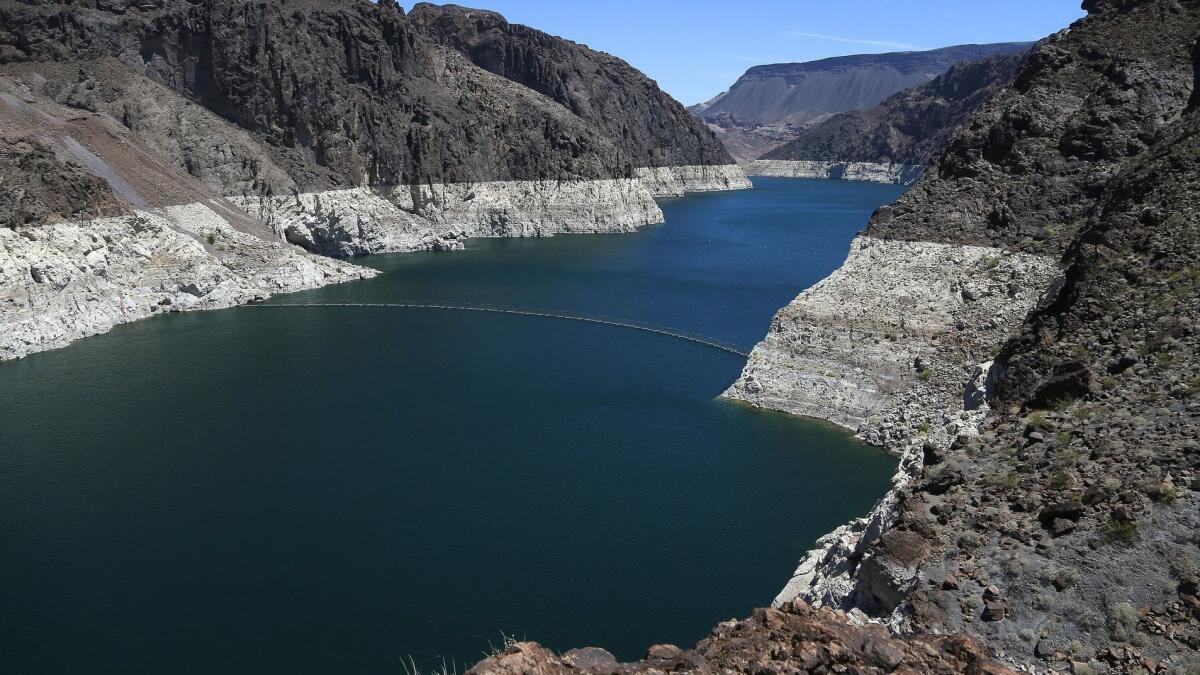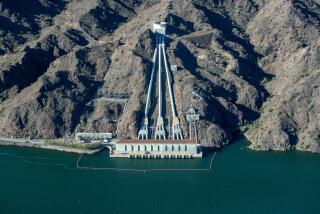Column: Despite signs of interstate cooperation, the decline of Lake Mead isn’t near being solved

On the surface, things have seemed to be looking up in recent weeks for the future of Lake Mead.
The Western storms of the last month have fostered the impression of a respite, at least temporarily, from the region’s long drought. Earlier this month, Arizona legislators passed a sheaf of crucial measures signaling their willingness to cooperate in an interstate drought contingency plan, staving off federal intervention.
Yet these are stopgaps. The giant reservoir on the Colorado River behind Hoover Dam, which provides water chiefly to residents in California and farmers there and in Arizona, is suffering from a long-term and possibly irreversible decline in capacity.
Putting something this complicated together with this many states is something to be commended, assuming it gets done.
— Jeffrey Kightlinger, general manager, Metropolitan Water District
The ultimate danger is that the lake reaches the “dead pool” stage. At the end of January, the lake was at 1,086 feet of surface elevation above sea level. When it reaches 1,050 feet, the lake can no longer generate hydroelectricity. At 895 feet, it can’t provide water.
Lake Mead’s enemies are both natural and man-made. Climate change has placed the Colorado River basin in a long-term drought. Meanwhile, human demands for water from the Colorado have far outstripped what it can provide.
“We’re in the 19th year of a drought,” observes Robert Glennon, an expert on water policy at the University of Arizona, “and it’s pretty obvious that climate change is having a devastating impact.” That places a premium on interstate cooperation to address the drought’s consequences — chiefly how to apportion what is certain to be a diminishing supply of Colorado water.
The fate of Lake Mead really was sealed in 1922, well in advance of its existence, with the drafting of a seven-state compact governing distribution of the waters of the Colorado River. (Besides California and Arizona, the states are Nevada, Colorado, Utah, Wyoming and New Mexico.) To secure the agreement clearing the way for Congress to advance money for the dam, then-Commerce Secretary Herbert Hoover deliberately overestimated the river’s capacity so that no state would fear getting shortchanged.
Construction of the dam and the filling of Lake Mead helped fuel epic population growth in the Colorado River basin, especially in California. Eventually it became clear that growth would outstrip the river’s capacity to deliver all the water that was promised.
On the lower basin (California, Arizona and Nevada), “we’re using 1.2 million more acre-feet than the river hydrology provides,” says Jeffrey Kightlinger, general manager of the Metropolitan Water District of Southern California, one of the largest users of Lake Mead water. “Effectively, we’ve been able to get away with it because the upper basin hasn’t developed as rapidly. But we’re living on borrowed time.”
One acre-foot equals about 326,000 gallons, enough to serve one or two average California households.
The MWD, the principal source of water for Southern California residents, gets about 15% of its water from the Colorado, 30% from Northern California via the State Water Project, and the rest from local sources, including groundwater and transfers from agricultural districts.
The consequences of overusing the Colorado, intensified by the effects of climate change, are starkly visible in the “bathtub ring” of white minerals on the shores of Lake Mead, showing its decline from its highest water levels. The lake last peaked at more than 1,200 feet above sea level in 1997-2000.
“It’s in everyone’s interest to play nice,” Glennon told me. “No one wants to bring this to the courts. The 20th century was consumed with that, and it was fraught with enormous expense, delays and bad will. For the last 20 years, the states have recognized that coordination and cooperation are much better than litigation.”
But coordination and cooperation are easier said than done. The supply and usage of water in the West is a vast web in which plucking on any strand sends vibrations across the region.
The claimants of Colorado River water include states, irrigation districts, tribes, farmers and urban dwellers, all of whom have conflicting interests and water rights. Overseeing them all, at least theoretically, is the federal government, which built Hoover Dam and still has ultimate jurisdiction over the reservoir through the Bureau of Reclamation.
What’s at issue is an update to an interim agreement reached in 2007 that dictates supply reductions in the lower basin as the level of Lake Mead falls. Arizona faces the harshest and nearest-term cuts, in part due to agreements dating from the 1960s that allowed it to build the Central Arizona Project, a huge aqueduct for its agricultural users.
California retains its water rights the longest — its annual apportionment of 4.4 million acre-feet is safe unless the level of Lake Mead falls to 1,045 feet above sea level or less. At that point the state has to start giving up some of its Colorado River water.
Hydrological modeling by the MWD indicates that there’s a 50-50 chance of the reservoir reaching that level by 2026. If the drought’s impact becomes that severe, under most scenarios California would lose a bit less than 25% of its allocation.
Since 2007, Reclamation officials say, the risk of a drop in the lake to “critically low levels” has increased more than fourfold. That placed a premium on reconsidering the interim guidelines to make them consistent with the greater risk.
The federal government has been applying intense pressure on the basin states and their water users to reach a final drought contingency plan. Reclamation Commissioner Brenda Burman fired a shot across their bows on Feb. 1, setting a tight deadline for California and Arizona, the river’s major users, to agree on a plan. As my colleague Bettina Boxall reported, Burman said that without a deal, the Interior Department would begin to develop its own plan.
That threat seemed to yield fruit a few days later, when the Arizona Legislature passed the required measures.
But many loose ends still exist. For one thing, an update to the interim plan would last only until 2026. “The plan basically gives us seven years to work out what our 50-year strategy should be,” Kightlinger says.
The most important uncertainty involves the fate of the Salton Sea, the inland body of water that was created by a flood from a botched canal project on the Colorado at the turn of the last century. Since that time, the sea has become an important way station for migratory birds.
But it has suffered from decades of neglect. The result of the drying out of the sea has been an environmental and health crisis, Jim Hanks, a board member of the Imperial Irrigation District, which borders on the sea, said at an IID board meeting on Feb. 5. He spoke of “crops ruined by toxic dust, an asthma epidemic, and a worsened international environmental crisis in our backyard.”
The Salton Sea’s condition could give the IID a strong hand to play in the future of Lake Mead. While it may be too much to say that fixing the Salton Sea is the key to fixing Lake Mead, a failure to address the sea’s deteriorating condition could hamper efforts to reach agreement over the reservoir.
The IID, which is entitled to the largest allocation of Colorado River water in California, put its foot down on Dec. 10, when its board effectively approved the interstate drought plan — with three conditions. Two demanded the right for IID to review and approve the final drought plan and any federal legislation to implement it. The third demanded an irrevocable commitment by California and the federal government to fund a $400-million, 10-year preservation program for the Salton Sea.
The state has tried to do its part. A water bond approved by voters in June allocated $200 million for a restoration and mitigation program for the sea. But a second bond appropriating another $200 million was rejected at the ballot box in November.
That passed the ball to the feds. Sen. Dianne Feinstein (D-Calif.) and Rep. Raul Ruiz (D-Palm Desert) managed to place language in the federal farm bill enacted in December that would allow government funds to be spent on the Salton Sea, but didn’t specifically allocate any money.
Since then, Feinstein and IID officials have been trying to get Agriculture Secretary Sonny Perdue to commit the federal government to filling the $200-million shortfall, so far without success. In January, the IID asked Perdue for a meeting, but has received no reply, according to IID spokesman Antonio Ortega.
Meanwhile, Reclamation Commissioner Burman has pushed back on IID’s conditions. “I would caution folks … not to add unrealistic demands” to approvals of the drought plan, she said during a meeting in December. Burman didn’t explicitly refer to the Salton Sea, but the implications were obvious to IID.
“Clean air and clean water for Imperial Valley residents and our environment are not unrealistic demands,” Hanks said on Feb. 5.
The IID doesn’t seem inclined at this moment to back off its demand for the Salton Sea funding. “The IID considers the Salton Sea, and what happens to it, as an essential component” of the drought plan, Board President Erik J. Ortega said at the Feb 5 meeting.
Any intervention by the government of the sort Burman has hinted at would inject a new level of uncertainty into interstate arrangements that already are hellishly complicated.
The rights of the Interior Department, Reclamation’s parent agency, to apportion a shortage among the states has never been tested in court, and no one is especially eager to do so. No one is sure whether the government could go beyond cutting allocations to the states and actually dictate how the cuts would be allocated within the states — say between IID and the MWD.
“No one likes chaos and litigation,” Kightlinger says. To plan long-term water distribution for 19 million residents of six Southern California counties requires “peace and calm,” he says.
The seven states have come close to reaching an agreement; the question is how close is enough?
“We’ve got a huge, long-term threat on the Colorado River,” Kightlinger says. “This is a good step, but it’s only going to buy us less than a decade. We need to get this done and move on to 25- to 50-year programs.
“With this many parties — a lot of legal rights, a lot of priorities, a lot of lawyers — putting something this complicated together with this many states is something to be commended, assuming it gets done.”
Keep up to date with Michael Hiltzik. Follow @hiltzikm on Twitter, see his Facebook page, or email [email protected].
Return to Michael Hiltzik’s blog.
More to Read
Inside the business of entertainment
The Wide Shot brings you news, analysis and insights on everything from streaming wars to production — and what it all means for the future.
You may occasionally receive promotional content from the Los Angeles Times.











